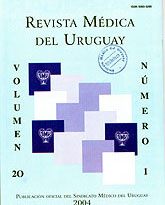Uso de quimioterapia en la insuficiencia renal
Resumen
La indicación de quimioterapia en pacientes con deterioro de la función renal plantea dificultades al oncólogo médico. Contribuye a esto la incorporación de nuevos fármacos citotóxicos, el estrecho margen terapéutico de la quimioterapia y la frecuente subvaloración de los mecanismos de absorción, transporte y eliminación de los fármacos.
Es necesario realizar ajuste de la posología cuando el índice de filtración glomerular es inferior a 50 ml/minuto y para aquellos fármacos antineoplásicos con eliminación predominantemente renal.
El objetivo de esta presentación es revisar la información sobre el uso de quimioterapia en pacientes neoplásicos con deterioro de la función renal.
Se revisa el tema en sus aspectos clínicos y farmacocinéticos.
Citas
2) Tabernero J. Empleo de fármacos en la insuficiencia renal. In: Sellares V, Torres A, Hernández D, Ayus J. Manual de nefrología clínica, diálisis y tranplante renal. Madrid: Harcourt, 1998: 1061-77.
3) Valsecia M, Malgor L. Utilización de fármacos en insuficiencia renal. http://med.unne.edu.ar/posgrado/farmacología/temas_farma/volumen5/11_rinion.pdf [Consulta: 8 julio 2002].
4) Rowland M. Renal function impairment. In: Rowland M, Tozer T. Clinical Pharmacokinetics: concepts and applications. Philadelphia: Lea & Febiger, 1980: 230-45.
5) Tamargo J. Uso de medicamentos en la insuficiencia renal. In: Rodés Teixidor J, Guardia J. Medicina Interna. Barcelona: Masson, 1997: 2434-40.
6) Lott R, Hayton W. Estimation of creatinine clearance from serum creatinine concentration. Drug Intell Clin Pharm 1978; 12: 140-50.
7) Grochow L. Covalent DNA-binding drugs. In: Perry M. The Chemotherapy Source Book. 2 ed. Baltimore: Williams & Wilkins, 1997: 293-343.
8) Kamizuru M, Iwata H, Terada T, Kato S, Yoshihara H. Chemotherapy in hemodialysis patient with metastatic testicular cancer; pharmacokinetics of etoposide and cisplatin. Nippon Hinyokika Gakkai Zasshi 2000; 91(7-8): 599-603.
9) Tomita M, Kurata H, Aoki Y, Tanaka K, Kazama JJ. Pharmacokinetics of paclitaxel and cisplatin in a hemodialysis patient with recurrent ovarian cancer. Anticancer Drugs 2001; 12(5): 485-7.
10) Calvert AH, Newell DR, Gumbrell LA, O’Reilly S, Burnell M, Boxall FE. et al. Carboplatin dosage: prospective evaluation of a single formula based on renal function. J Clin Oncol 1989; 7(11): 1748-56.
11) Yanagawa H, Takishita, Y, Bando H, Sumitani H, Okada S. Carboplatin-based chemotherapy in patients undergoing hemodialysis. Anticancer Res 1996; 16(1): 533-46.
12) English MW, Lowis SP, Peng B, Boddy A, Newell DR, Price L, et al. Pharmacokinetically guided dosing of carboplatin and etoposide during peritoneal dialysis and haemodialysis. Br J Cancer 1996; 73(6): 776-80.
13) Gutheil J, Kearns C. Antimetabolites. In: Perry M. The Chemotherapy Source Book. 2 ed. Baltimore: Williams & Wilkins, 1997: 317-43.
14) Wall SM, Johansen MJ, Molony DA, DuBose TD Jr, Jaffe N, Madden T. Effective clearance of methotrexate using high-flux hemodialysis membranes. Am J Kidney Dis 1996; 28(6): 846-54.
15) Thomson AH, Daly M, Knepil J, Harden P, Symonds P. Methotrexate removal during haemodialysis in a patient with advanced laryngeal carcinoma. Cancer Chemother Pharmacol 1996; 38(6): 566-70.
16) O’Reilly S, Rowinsky EK, Slichenmyer W, Donehower RC, Forastiere AA, Ettinger DS, et al. Phase I and pharmacologic study of topotecan in patients with impaired renal function. J Clin Oncol 1996; 14(12): 3062-73.
17) Herrington JD, Figueroa JA, Kirstein MN, Zamboni WC, Stewart CF. Effect of hemodialysis on topotecan disposition in a patient with severe renal dysfunction. Cancer Chemother Pharmacol 2001; 47(1): 89-93.
18) Carlson L, Goren MP, Bush DA, Griener JC, Quigley R, Tkaczewski I, et al. Toxicity, pharmacokinetics, and in vitro hemodialysis clearance of ifosfamide and metabolites in an anephric pediatric patient with Wilms’ tumor. Cancer Chemother Pharmacol 1998; 41(2): 140-6.
19) ROCHE. Xeloda (Capecitabine); Product monograph. Basel: Roche, 1998: 40 p.
20) Cassidy J, Twelves C, Van Cutsem E, Hoff P, Bajetta E, Boyer M, et al. First-line oral capecitabine therapy in metastatic colorectal cancer: a favorable safety profile compared with intravenous 5-fluorouracil/leucovorin. Ann Oncol 2002; 13(4): 566-75.
21) Crooke ST, Comis RI, Einhorn LH, Strong JE, Broughton A, Prestayko AW. Studies on the clinical pharmacology of bleomycin. Recent Results Cancer Res 1978; 63: 219-29.
22) Powis G. Effect of human renal and hepatic disease on the pharmacokinetics of anticancer drugs. Cancer Treat Rev 1982; 9(2): 85-124.
23) Eli Lilly Company. Gemzar ® (gemcitabine HCl) for injection (prescribing information). www.pi.lilly.com/gemzar.pdf . [Consulta: 4 setiembre 2003].
24) Donehower R, Rowinsky E. DNA Topoisomerase Inhibitors. In: Perry M. The Chemotherapy Source Book. 2 ed. Baltimore: Williams & Wilkins, 1997: 434-45.














